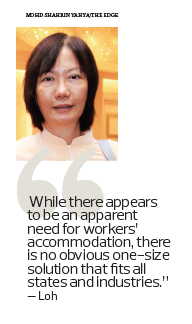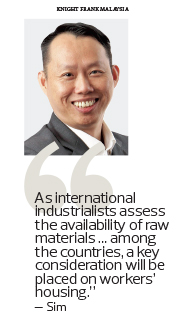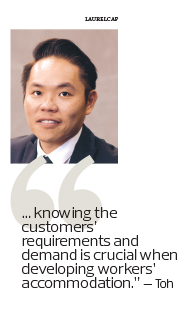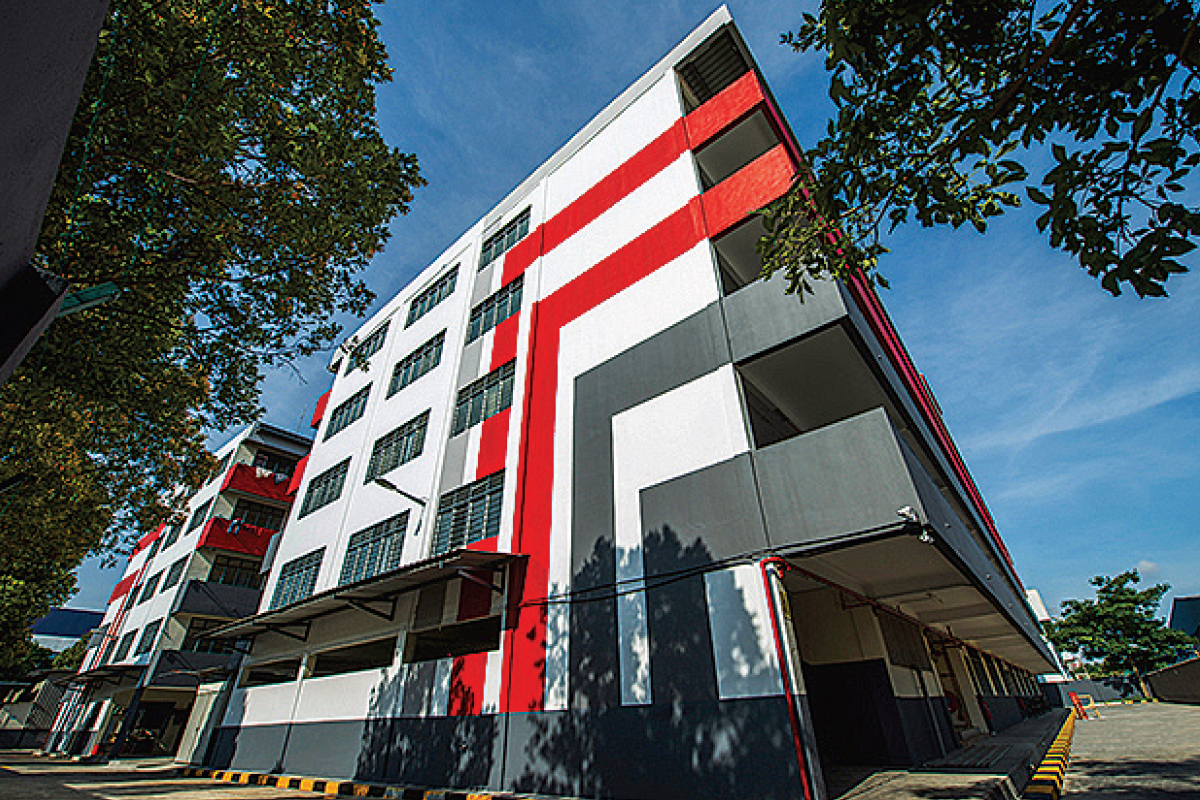
This article first appeared in City & Country, The Edge Malaysia Weekly on November 29, 2021 - December 5, 2021
The Covid-19 pandemic has uncovered several deep-rooted issues in the country, one of which is the existence of a large number of low-skilled foreign workers in labour-intensive industries.
The accommodation for these workers is normally arranged by their employers. Unfortunately, many of the dormitories are cramped, creating an undesirable living environment. There are regulations on workers’ accommodation, but the lack of enforcement has made them ineffective.
In a recent publication on workers’ dormitories, Knight Frank Malaysia observes that most industries use terraced homes, apartments, shophouses and makeshift accommodation to house their workers, while professionally managed dormitories are unexplored propositions.
“Most of these types of housing were crowded and had poor sanitation, leading to many social issues that have burdened the community for years. The perception of higher cost and non-standard guidelines [by local authorities] in different states have also led to years of resistance from industry players to provide dedicated workers’ accommodation,” it says, adding that the lack of awareness and accountability has compounded the problem.
According to the International Labour Organization (ILO), there are no universally applicable regulations related to workers’ accommodation standards in general, says Veena Loh, director of research and consultancy at JLL Property Services (Malaysia) Sdn Bhd.
“For dormitories, ILO suggests ideally 4 to 5.5 sq m of floor space per resident, which developed countries such as Singapore have complied with. A minimum ceiling height of 2.1m is ideal,” she tells City & Country.
“In collective rooms, which are to be minimised, in order to provide workers with some privacy, only a reasonable number of workers — 2 to 8 — are allowed to share the same room, and no hot bedding is allowed.”
In countries such as Singapore and Qatar, Covid-19 has spread aggressively in workers’ accommodation. But even before the pandemic, the workers had barely enough living space, making physical distancing a luxury for them.
Loh says ILO’s stand is that it is generally not desirable for employers to directly provide housing for their workers, and employers should use alternatives where possible.
“While there appears to be an apparent need for workers’ accommodation, there is no obvious one-size solution that fits all states and industries. The benchmarks provided by ILO need to be studied to see if they are adaptable and suitable here,” she adds.
“Implementation can be difficult because Malaysia is a large country with different types of industries, including manufacturing, construction, mining, plantation and agriculture, that may require different solutions to workers’ accommodation. The uncertainty of the future of the workers also makes it impossible to build anything fast enough to accommodate existing workers, who may or may not be around when the dormitories are completed.”
Many countries have acted promptly to tackle the issue of workers’ accommodation. Singapore, for example, plans to house the workers in temporary housing before moving them to larger, permanent accommodation.
New regulations in Malaysia
In Malaysia, the government has tightened laws related to workers’ accommodation and implemented stricter enforcement. The labour-intensive sectors have been working towards compliance with the latest laws.
Prior to the pandemic, the Workers’ Minimum Standards of Housing and Amenities Act 1990 (original Act) was already in place, but there had been a lack of enforcement for years. The Act is now known as the Employees’ Minimum Standards of Housing, Accommodations and Amenities Act 1990 (amended Act).
Human Resources Minister Datuk Seri M Saravanan was quoted as saying that the amended Act was gazetted in February 2021 as part of the Emergency Ordinance that is also enforced in Sabah and Sarawak to address housing management issues through stricter enforcement action.
The laws that guide the enforcement of workers’ accommodation are thus the amended Act, as well as all the regulations enacted under the amended Act. The laws came into effect on June 1, 2020, in Peninsular Malaysia and Labuan. Employers were given a three-month grace period until Aug 31 to fully adhere to the laws.
The amendments stipulate that, among others, an employer or a centralised accommodation provider has to comply with the minimum statutory requirements stated by the Department of Labour of Peninsular Malaysia, which include:
• Provision of “bedroom” with a minimum floor area of 3 to 3.6 sq m for each employee, depending on whether the provided accommodation is a dormitory or not;
• Minimum of one toilet and one bathroom for 15 employees in a dormitory, or six if it is not a domitory;
• Provision of non-shareable items such as bed, mattress, pillow and locker; and
• Provision of common-use areas such as kitchen, living room, toilet and bathroom.
Opportunities
Knight Frank Malaysia executive director of capital markets Allan Sim observes that years of resistance from employers to dedicated workers’ accommodation arose from the perception that it would lead to higher costs. However, with the government’s efforts, employers are now provided with incentives to adopt more socially responsible accommodation practices to contain Covid-19 and comply with the new regulations.
“The earlier resistance is slowly dissipating, with more employers being educated on the importance of having proper workers’ housing as a value add to the sustainability of the whole manufacturing supply chain. Stronger cooperation between the federal government and other stakeholders such as policymakers, state authorities/government agencies, developers, operators and industrialists/end users are required to provide a more inclusive and holistic approach to improve the current frameworks governing this emerging asset class during the pandemic and beyond,” he says.
Following the new legal requirements, the development of workers’ accommodation in Malaysia is on an upward trend. For instance, glove maker Top Glove Corp Bhd said in December last year that it spent about RM20 million to buy 100 apartments to serve as workers’ hostels and RM50 million on 100 double-storey houses and hostels in its endeavour to comply with the new guidelines on minimum standards for workers’ housing.
Sim observes that employers are looking to comply with the legal requirements by building, purchasing and/or renting purpose-built and/or converted dormitories for their workers, while investors and developers embark on partnerships with these employers to construct build-to-lease workers’ accommodation for recurring income.
“At the moment, our observation tends to suggest that the development of workers’ accommodation is more on a project basis. Interest from institutional funds — which have been monitoring this asset class closely — are expected to grow as more quality supply of dormitories are made available in the mid to longer term and when this sub-market becomes more mature,” he says.
Laurelcap Sdn Bhd executive director Stanley Toh concurs. He believes that most employers would choose to look at existing apartment buildings nearby to house their employees than build accommodation from the ground up.
“Since there is an oversupply of high-rise accommodation in most states, renting an existing apartment for their workers would be cheaper, easier and faster. This also gives opportunities to developers and contractors for a new type of business, of building workers’ accommodation specifically targeting factory workers for the sake of complying with the Act,” he says.
“Location is a major factor, as it needs to be very near [walking distance] to the factories. It is also a numbers game, as you need economies of scale to achieve a low rent cost per person for the factories or construction companies to consider lodging at your facility. Hence, it would be good for workers’ accommodation to be in a dense industrial estate.”
JLL Property Services country head YY Lau reckons that there are many factors that would determine the success of developing and managing workers’ accommodation in Malaysia, such as finding the right location at the right cost, pricing it correctly and having a good operator.
It is important for the operator to undertake a feasibility study, she adds, to see if the fees charged will be sufficient to ensure that the business is sustainable and that the firm has sufficient financial resources and borrowings to keep afloat in the first few loss-making years of paying off the land and construction of the building and amenities that are stipulated in the Act.
“The choice of location to serve the needs of the companies that are using these workers is important, as companies or workers will consider the transport cost of going from the dormitory to the workplace. There could be opportunities to create workers’ accommodation in states like Penang, Selangor and Johor, where a significant number of foreign workers are employed,” says Lau.
While the short-term solution would benefit existing property owners and investors in terms of rental income, property consultants believe that, in the long run, centralised workers’ accommodation will be the way forward. These can be complementary products that developers of industrial parks can include in the masterplan of their projects.
Centralised labour quarters
Property consultants also expect to see a growing interest in centralised labour quarters. Lau cites Singapore-based Centurion Corp Ltd (CCL) as an example. Focusing on building and operating centralised workers’ accommodation, the company is one of the largest providers of workers’ accommodation in Singapore and Malaysia.
“Over time, there could be more local parties entering the business, using the business model of CCL. With the enforcement of the labour guidelines, it would appear that there is a market for workers’ accommodation for serious players,” she says.
“Currently, large manufacturing players such as Top Glove and Hartalega house their own workers. Some of these players may need to build bigger units or renovate existing units to comply with the Act.”
Toh points out that CCL secured a contract from the Selangor State Development Corporation (PKNS) in 2020 to lease a ready-built property in Sungai Way, Petaling Jaya, that comes with 6,044 beds for workers’ accommodation.
“It is the group’s entry into Selangor, and it adds 36,744 beds to the total capacity of purpose-built workers’ accommodation in Malaysia. I guess with the pandemic, which is here to stay for some time, Malaysian companies will see great opportunities and will catch up in a short period of time,” he says, adding that workers’ accommodation will need more awareness and enforcement going forward.
Nevertheless, Knight Frank’s Sim notes that it is important to take a step back and assess the situation, as workers’ accommodation should not be viewed as a standalone asset class but rather a subset of the larger industrial ecosystem. “Having proper and professionally managed workers’ accommodation will complete the offering and place Malaysia on a stronger footing to compete with other countries in the region in attracting foreign direct investment into the manufacturing sector,” he says.
“As international industrialists assess the availability of raw materials, talent pool and real estate costs among the countries, a key consideration will be placed on workers’ housing, especially with the increased scrutiny brought about by the pandemic.”
He adds that workers’ accommodation could transcend the bread-and-butter offerings and may encompass higher quality centralised housing to accommodate skilled and high-grade workers. Such a move will help elevate and strengthen Malaysia’s position in becoming a high-value manufacturing hub. Subsequently, it will have a direct positive impact on the industrial real estate segment and a larger multiplier effect on the residential and commercial segments.
“This backdrop would entice the interests of operators that manage higher quality centralised workers’ housing, where technologies are incorporated to provide higher-quality accommodation for potential employees and workers in the high-value manufacturing sector,” says Sim.
Investments
Property consultants see the possibility of injecting these workers’ accommodation into real estate investment trusts (REITs) when the market is big enough.
Laurelcap’s Toh says, “As businesses are scaling down in terms of office space, REITs may pivot to workers’ accommodation just like student accommodation overseas. As long as the demand for workers’ accommodation is present, the business will be able to sustain in the long run.”
Knight Frank’s Sim calls it “an interesting investment opportunity”, as while the asset class is residential in nature, it shares some characteristics with the industrial segment that investors currently favour.
Workers’ accommodation contracts, he points out, will generally be longer term, as manufacturers will account for their workers’ housing when considering the projected investment horizon for their manufacturing plants.
“Unlike other asset classes such as hotels, the general investment is lower from the initial construction as well as the recurring capital expenditure, as there are fewer stringent requirements on periodic upgrades as there are fewer fitouts. From an investment point of view, it seems that workers’ accommodation may present as a lower risk investment from the above characteristics, and it will be interesting to observe how the long-term market yield will reflect the above,” says Sim.
Challenges
As centralised workers’ accommodation is still a relatively new property segment in Malaysia, property consultants believe that dedicated nationwide guidelines for these developments are essential.
Also, according to Sim, it is important to raise awareness among employers of the benefits of having centralised workers’ accommodation and how it has a direct correlation to productivity.
On top of that, the challenges would be managing the workers and ensuring that they comply with the standard operating procedures, says JLL’s Lau.
“The new Act requires a responsible employee in charge of the centralised accommodation to take preventive measures to contain the spread of infectious diseases. The employee has a duty to take a worker to a hospital should he or she appear unwell or suffer from any medical condition, and keep a record of health complaints. Poor management and infection cases could lead the operator to run the risk of low occupancy in the workers’ accommodation,” she adds.
Toh notes that as such accommodation is highly populated, it is a challenge when it comes to keeping order or managing the facility. Nevertheless, the quality of the accommodation will depend on the segment of workers.
“There are two main segments of workers — highly skilled labour, such as those working in high-technology or semiconductor factories, and low-skilled labour, such as those working at glove factories, among others. The quality or grade of accommodation will differ. Hence, knowing the customers’ requirements and demand is crucial when developing workers’ accommodation,” he says.
Sim reckons that managing the operations of workers’ accommodation is of great importance. “Professional operators will be able to add value to the hard assets by ensuring that the workers’ dormitories are properly managed in terms of security, the workers’ social and mental well-being, local culture assimilation via learning and communication, and health and medical welfare. These are all key factors to distinguish normal dormitories from ones with professional administration,” he says.
A better living environment for foreign labour could translate into higher productivity for employers while building a good image for the country. As the government tightens its enforcement on workers’ accommodation, support and cooperation from all stakeholders are needed.
Save by subscribing to us for your print and/or digital copy.
P/S: The Edge is also available on Apple's App Store and Android's Google Play.





